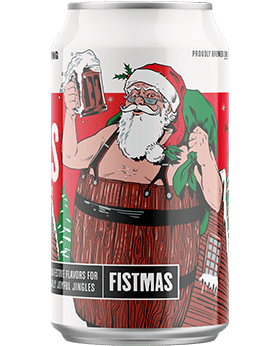Revolution Brewing Co.’s Fistmas clone
(5 gallons/19 L, all-grain)
OG = 1.068 FG = 1.018
IBU = 30 SRM = 21 ABV = 6.5%
Appropriate for the season, Fistmas is a holiday beer for hopheads! “As a homebrewer, I always would do spiced ales around the holidays,” Revolution Head Brewer Jim Cibak said, “but honestly, they just wore out my palate. Fistmas goes more with Revolution’s theme of brewing hoppier beers.”
Ingredients
12 lbs. (5 kg) North American 2-row pale malt
15 oz. (425 g) Weyermann CaraMunich® III malt
7 oz. (198 g) Weyermann CaraRed® malt
6.8 oz. (193 g) red wheat malt
2.4 oz. (68 g) Weyermann CaraMunich® II malt
1.2 oz. (34 g) Weyermann Special W® malt
0.2 oz. (6 g) Weyermann Carafa® Special Type III malt
1.5 AAU Herkules hops (80 min.) (0.1 oz./2.8 g at 15.1% alpha acids)
0.3 oz. (8.5 g) Cascade hops (0 min.)
0.7 oz. (20 g) Chinook hops (0 min.)
2 oz. (57 g) Chinook hops (dry hop)
1.6 oz. (45 g) Citra® hops (dry hop)
0.24 oz. (6.8 g) crystallized ginger (0 min.)
1 oz. (28 g) sweet orange peel (0 min.)
1 oz. (30 mL) Biofine Clear (or similar fining)
Wyeast 1968 (London ESB Ale), White Labs WLP002 (English Ale), or Mangrove Jack’s M15 (Empire Ale) yeast
3⁄4 cup corn sugar (if priming)
Step by step
This recipe uses a single-infusion mash at a ratio of 3:1 water-to-grain. Add 4.6 gallons (17.4 L) of water at 164 °F (73 °C) to the mash/lauter tun and stir in 1⁄4 tsp. gypsum and 3⁄4 tsp. calcium chloride. Mash in grains targeting a temperature of 154 °F (68 °C) and rest there for 40 minutes. Vorlauf slowly for 10 minutes to complete starch conversion and clarify wort before collecting in the brew kettle.
Collect first runnings in kettle (take a first wort gravity and pH reading). Start sparging 170 °F (77 °C) water when the grain bed is beginning to become exposed. Fill your kettle to 7 gallons (26.5 L) of wort, cutting your sparge at about 6 gallons (23 L) to allow the sparge water to pull through the grain bed.
Total boil time is 80 minutes, with the first hop addition added at the beginning of the boil. At the end of the boil, place ginger and orange peel in a nylon bag and add it plus the whirlpool hops and use a spoon or paddle to get your wort spinning to break up all of the hop pellets. Once you are done stirring your wort, start a 20-minute timer to allow your trub pile to form.
After your whirlpool, cool wort to 66 °F (19 °C) and pitch yeast. If using a liquid strain and you have an oxygen tank and regulator, Revolution targets their oxygen flow at 8 L/min. during the entire transfer of wort to the fermentation tank. Transfer as much clean wort away from your trub as possible to maximize the volume you are sending to your fermentation tank. Ferment at 68 °F (20 °C) and follow the fermentation timeline:
Day 4: Check the gravity. When it is 1.020-1.022, 2–4 gravity points above terminal gravity, harvest or dump thick yeast that has settled to the bottom of the fermenting vessel (or rack to another carboy), add the dry hops, then raise the temperature of the fermenter to 70 °F (21 °C) to begin a diacetyl rest.
Day 8: Fermentation should be complete. Dump the trub that has settled to the bottom of your fermenter or rack to another carboy. Set temperature to 32 °F (0 °C) to further drop yeast and hop matter.
Day 10: Add Biofine or similar fermentation fining agent and gently swirl (or CO2 rouse your fermentation vessel from the bottom in you have a conical fermenter) to ensure good mixing. Within a few days of fining you should see a major improvement in clarity.
Day 12: Transfer to a keg and force carbonate or prime and bottle condition to 2.5–2.6 volumes of CO2.
Extract with grains option:
Replace the pale and red wheat malts with 7 lbs. (3.2 kg) extra light dried malt extract. Place the crushed grains into a muslin bag and steep in 5 gallons (19 L) brewing water as it heats up to 170 °F (77 °C). Remove the grains, allowing them to drip back into the kettle. Remove from heat and stir in the dried malt extract. Once fully dissolved turn the heat back on and bring to a boil.
Follow the remainder of the all-grain recipe instructions, being sure to top up the fermenter to 5.25 gallons (20 L) before starting fermentation.
Tips For Success:
Target a yeast pitch rate of 1 million cells/mL/°Plato. When using a liquid strain, having a healthy active yeast pitch going into fermentation and a yeast propagation before brewing this beer can be extremely beneficial.
Using the straining bag to contain the crystallized ginger and sweet orange peel makes it much easier to contain them and allow for easy removal from the whirlpool once transfer of wort to the primary fermenter is complete.
Removing the yeast and hops 3 to 4 days after the initial dry hop is crucial to retain the clean hop aromatics so the yeast doesn’t autolyze and the vegetal hop matter doesn’t begin to break down.
Keeping CO2 pressure in the headspace of your beer when the fermentation and dry hop are complete will help preserve hop aromatics, which is key for a beer like Fistmas.
Gently carbonating your beer to prevent foaming will also aid in your foam stability and let those hop aromatics you worked so hard to extract really shine!
Written by Chip Walton

Appropriate for the season, Fistmas is a holiday beer for hopheads! “As a homebrewer, I always would do spiced ales around the holidays,” Revolution Head Brewer Jim Cibak said, “but honestly, they just wore out my palate. Fistmas goes more with Revolution’s theme of brewing hoppier beers.”



